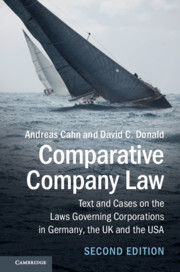 Comparative Company Law
Comparative Company Law Book contents
- Comparative Company Law
- Comparative Company Law
- Copyright page
- Contents
- Figures
- Tables
- Preface to the Second Edition
- Preface and acknowledgments
- Glossary
- Abbreviations
- Table of cases
- Table of legislation
- Part I The essential qualities of the corporation
- Part II The corporation and its capital
- Part III Governing the corporation
- Part IV Corporate combinations, groups and takeovers
- References
- Index
- References
References
Published online by Cambridge University Press: 24 September 2018
- Comparative Company Law
- Comparative Company Law
- Copyright page
- Contents
- Figures
- Tables
- Preface to the Second Edition
- Preface and acknowledgments
- Glossary
- Abbreviations
- Table of cases
- Table of legislation
- Part I The essential qualities of the corporation
- Part II The corporation and its capital
- Part III Governing the corporation
- Part IV Corporate combinations, groups and takeovers
- References
- Index
- References
Information
- Type
- Chapter
- Information
- Comparative Company LawText and Cases on the Laws Governing Corporations in Germany, the UK and the USA, pp. 1014 - 1034Publisher: Cambridge University PressPrint publication year: 2018